| Leonardo
da Vinci (1452-1519) also employed linear perspective in paintings which contained
architecture, and was one of the first artists to make note in his writings
about the existence of atmospheric perspective. To give the illusion
of receding depth in nature, he painted with warm tones in the foreground,
and cool tones in the distance. He also employed a sfumato effect
in his figures, one of the trademarks of his Mona Lisa. In addition,
he created mathematical formulas for human proportions. This is exemplified
in his famous drawing of the human figure inside of a square and a circle,
expressing the perfection of the harmony between mathematics and nature.
Combining science and art, he was the prototype of a Renaissance
Man. |
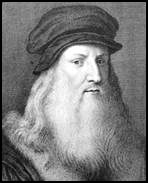 portrait by an unknown Tuscan artist
portrait by an unknown Tuscan artist |
THE
LIFE OF LEONARDO
A
Brief Biography of Leonardo da Vinci's life:
Apri1
15, 1452 - Leonardo was born in Vinci, near Florence. He was the
illegitimate son of a notary, Ser Piero, and a young woman named Caterina.
1457 - At five Leonardo moved to his father's
home. Meanwhile his father had married Alberia Amadori.
1460 - He moved to Florence with his father.
1469 - He began his apprenticeship in
Verrocchio's artisan workshop.
1482 - He moved to Milan where he carried to the court of Ludovico
il Moro a letter in which his services were recommended as an engineer, architect,
sculptor, painter and musician (paintings during this period included the
portrait of Cecilia Gallerani, "Lady with an Ermine", and the first
version of the "Virgin of the Rocks").
1495 - He began his best known work, the Last Supper, in the refectory of Santa Maria delle Grazie (completed
in 1499). The Duke Ludovico il Moro fell under the control of the French armies
of Louis XII. Leonardo abandoned Milan and started wandering from court to
court, from Mantua and Venice to Friuli.
1504 - He was once again in Florence where he began the Mona Lisa.
1508 - He returned to Milan where he took
up his studies on anatomy, town-planning, optics and hydraulic engineering.
1513 - Following the return of the Sforzas
as rulers of Milan once more, Leonardo moved to Rome on the invitation of
the pope, Giuliano dei Medici (Pope Leo X).
1516 - The King of France, François
I, invited him to France where, at the Castle of Cloux, near Amboise, he was
given the post of "first painter, engineer and architect to the King".
May 2, 1519 -Leonardo died at Cloux and
was buried in the Church of St. Valentine at Amboise, France. In his will,
dated April 23 of the same year, he bequeathed all his manuscripts, drawings
and various instruments and tools to his favourite pupil, Francesco Melzi.
LEONARDO'S
MANUSCRIPTS
Over
5000 drawings survived the centuries since Leonardo's death
Leonardo's notebooks are the chief claim to his genius, since many
of his paintings are unfinished or in poor repair. The sheer quantity of over
5000 drawings has not been approached by any other Renaissance artist, and
few things escaped the range of his interests. Among his subjects were men,
women, horses, dogs, trees, flowers, fruit, moving water, monsters, caricatures,
anatomy, architecture, mechanical diagrams, and maps. These incredible records
were almost lost .
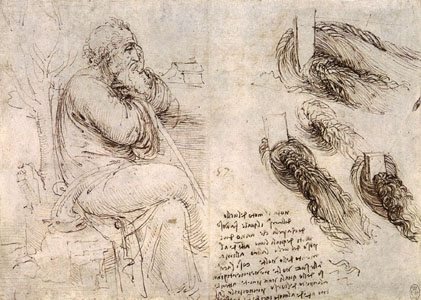
|
Old Man and Water
Studies:
One of Leonardo's pioneering
interests were his studies of the patterns of flowing water. Long before
slow-motion photography, he was probably the first to grasp the geometrical
swirling of currents. In his notes, he even makes mention to its similarity
with the curls of hair. It is unknown who the old man in this drawing
is. I like to think of it is a self-portrait... a picture of the artist
alongside one of the problems which took much of his focus). |
In his will, dated
April 23, 1519, Leonardo bequeathed all his manuscripts, drawings
and various instruments and tools to his favorite pupil, Francesco
Melzi. With the death of Melzi in 1570, the manuscripts were
scattered by Melzi's heirs. Having no idea of their importance,
they initially stored Leonardo's drawings and manuscripts in
a loft, later giving parts of it away or selling sheets cheaply
to friends and collectors. A significant portion fell into the
hands of a sculptor named Pompeo Leoni, who lost part of the
collection and also rearranged the order of its contents. In
an effort to sort the artistic drawings from the technical ones,
he split up the original manuscripts, cut and pasted pages and
created two separate collections. Leonardo's manuscripts are
today nothing like the way they appeared and were grouped together
during his lifetime. Today they consist of several bound volumes
which are scattered in collections across the world.
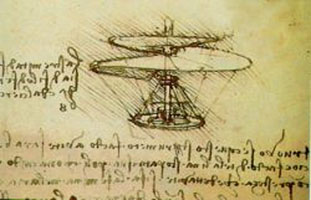
Leonardo's design for a helicopter employed
the use of a giant screw to displace the air.
|
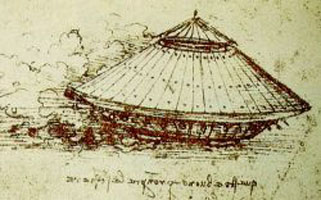
Leonardo's design for an armored car.
The idea became actualized only centuries later
|
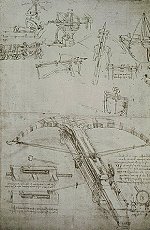 |
Since
the primary function of Leonardo's employment for the Duke of Milan
was to be a military engineer, his notebooks include many designs for
military machines, such as this design for a crossbow, at left. It was
also probably for the duke that he devised the armored car (above).
His notebooks also describe a chariot with revolving knives at the axles,
catapults, and even stink bombs! He also employed as an architect, and
there are many drawings related to the design of cathedrals. The study
of weights and hydraulic machines may have also been related to his
employment with the duke. His personal interests were recorded in his
study of the flight of birds, optics, geometry, the movement of water,
anatomy, geography, horse studies, and a series of maps. He also did
drawings in preparation for his paintings, and many studies of the diversity
of human expressions. The manuscripts also contain numerous pages testifying
to Leonardo's self-taught efforts to improve his literary education.
He was, in every sense of the term, a true "Renaissance Man". |
|
Flying Machines:
It was from Leonardo's studies of the flight of birds that he was
able to devise his inventions of flying machines. It is known that
he created models from some of these drawings, though he was never
actually able to make any of them fly. Some of themhave since been
recreate into models by the Leonardo Museum in the town of Vinci.
See http://www.leonet.it/comuni/vincimus/inptfram.html |
 |
Anatomical Studies:
Leonardo was one
of the first artist/scientists to systematically map the human body
in his drawings. This work began as a preliminary understanding for
the purpose of creating art, but once he entered this field (like so
many other of Leonardo's pursuits) it brought him into a whole new world
of study. Leonardo claimed to have dissected more than 30 cadavers of
both sexes and all ages. He also made notes on comparative studies between
the larger animals.
I noticed that this
embryonic drawing is accompanied by smaller images of seeds, thus comparing
human anatomy with botany. Probably the first image of an embryo which
is still in the womb, it is one of his most famous studies. |
Grotesque Old Men:
Leonardo was equally
interested in images of beautiful youths and ugly, toothless men. He
felt that it was important to study all human characteristics for their
expressive potential. His ability to render anything that captivated
his interests creates a beautiful drawing, though the subject may be
a caricature of grotesque features. |
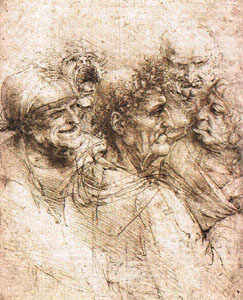 |
The numerous studies of horses
which Leonardo created are probably related to the Colossal Horse statue
that he was commissioned to create as a memorial for the duke of Milan.
He created a gigantic clay sculpture of the horse and gave detailed instructions
for how it was to be cast in bronze. The drawing at right is a diagram
for an armature that was to hold the separately cast pieces together.
See story below. |
Leonardo's Colossal Horse
Recreated
(Smithsonian Article, September 98)
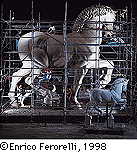
In the days when Milan was one of the richest and most powerful
city-states in northern Italy, its duke, Ludovico Sforza, liked
to do things in a grand way. In 1482 he commissioned Leonardo
da Vinci to create the biggest horse statue ever. Made to honor
the duke's father, it was to be 24 feet high. Leonardo spent
years sketching a great charger, eventually sculpting a full-sized
model in clay and leaving notes about how to cast it - the bronze
would weigh 80 tons! But then a French army threatened and the
metal was needed for cannon. When Milan fell in September 1499,
Leonardo fled. French archers used the clay horse for target
practice. For more than four centuries it was lost to history.
Then a most unlikely thing happened. United Airlines pilot
Charles Dent, a lover of Italy and an amateur sculptor, saw copies
of the Leonardo sketches that had been rediscovered in Spain
in 1966. Dent sculpted a rough clay model of Leonardo's charger,
and resolved that somehow he would build the famous animal as
a gift from the American people to the people of Italy. Such
a horse looked like a 100-to-1 shot, but Dent persevered. He
created an organization, Leonardo da Vinci's Horse, Inc., which
raised $4 million.
The job of making the horse was given to the Tallix, Inc.,
foundry in Beacon, New York. Charles Dent died in 1994, but the
work went on, most recently under the direction of sculptor Nina
Akamu, who created the eight-foot master model. From it, a larger,
clay version was made and will be cast in bronze. On September
10, 1999, five hundred years to the day after the archers shot
Leonardo's model to pieces, the bronze horse - broken down into
seven manageable sections and flown for free from the United
States by Alitalia - will take its place on a pedestal in the
ancient city of Milan.
|
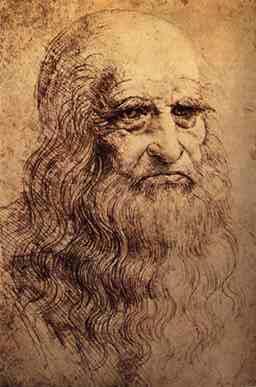 |
Leonardo
had intended to combine all of his notebooks into encyclopedaic volumes,
connecting all of the observed sciences. As he aged, he probably realized
that this work was never to be finished. He had also witnessed the beginnings
of deterioration of his most important work, the Last Supper, and the
total destruction of his colossal horse. Though still esteemed a great
painter, the reputation of his younger contemporaries, Michelangelo
and Raphael were succeeding his own, and he was no longer called upon
to create great commissions. He may have been concerned that the world
would soon forget him when he sat down to create his famous self-portrait.
His magnificence and sadness are recorded in his expression.
The
following is a list of some of the collections which contain the Leonardo
manuscripts: The Royal Windsor collection (London, England), The National
Library of Madrid (Spain), Biblioteca Trivulziana at the Castello Sforzesco
(Milan, Italy), Biblioteca Reale of Turin, Institute de France (Paris),
Victoria and Albert Museum (England), and a recently purchased collection
of Bill Gates. |
to Leonardo's Paintings
|